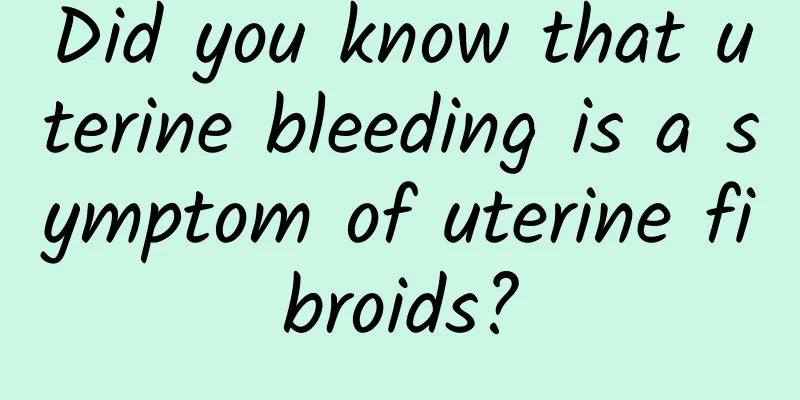Did you know that uterine bleeding is a symptom of uterine fibroids?

|
Whether uterine fibroids have symptoms and their severity are mainly determined by the location, size, number and complications of the fibroids. Some fibroids are small, grow slowly, and have no symptoms, and can remain undetected for a lifetime. Let our experts briefly introduce the symptoms of uterine fibroids to you and hope it will be helpful to you! In recent years, due to the widespread use of B-ultrasound examination, many patients were found to have uterine fibroids during routine physical examinations, but they themselves had no symptoms. Most patients came to the doctor because of the symptoms of uterine fibroids. Common symptoms of uterine fibroids include uterine bleeding, abdominal mass, vaginal discharge, compression symptoms, etc. Symptoms of uterine fibroids experts introduce to you: Uterine bleeding: Uterine bleeding is the most common symptom of uterine fibroids. Clinically, it can manifest as menorrhagia, cyclical bleeding, increased menstrual flow, often accompanied by prolonged menstruation. This type of bleeding is the most common; frequent menstruation, shortened menstrual cycle, increased menstrual flow; irregular bleeding, loss of normal menstrual periodicity, long duration, sometimes more, sometimes less, and continuous bleeding, which is more common in submucosal fibroids. Uterine bleeding is more common in submucosal fibroids and intermuscular fibroids, and subserosal fibroids rarely cause uterine bleeding. According to literature reports, the incidence of uterine bleeding in submucosal fibroids, intermuscular fibroids, and subserosal fibroids is 89.5% to 100%, 74% to 77.7%, and 33.3% to 36%, respectively. There are many explanations for the cause of uterine bleeding: ① Large or multiple intramuscular fibroids will inevitably increase with the enlargement of the uterus as well as the area of the endometrium in the uterus. During menstruation, a large area of endometrium is shed and the repair time is correspondingly longer, resulting in more bleeding and longer menstrual periods. ②The presence of fibroids between the muscle walls prevents the uterus from controlling bleeding through effective contractions, resulting in heavy bleeding. ③ Uterine fibroids mostly occur in the late reproductive age, during menopause. Some patients have small fibroids but heavy menstruation, which may be caused by concurrent dysfunctional uterine bleeding. This can be confirmed by curettage and examination of the endometrium. The above is a brief introduction of the symptoms of uterine fibroids by experts. Do you know them? If you have any questions about uterine fibroids, please consult our online experts. We will serve you wholeheartedly! Uterine fibroids: http://www..com.cn/fuke/zgjl/ |
<<: Why do women get ovarian cysts?
>>: Experts explain the causes of ovarian cysts
Recommend
What should I do if I have severe pelvic effusion during pregnancy?
What should I do if I have severe pelvic effusion...
Lower body weight loss method: (Part 1) Lower abdomen
How to slim down the lower body has always been o...
What medicine is good for women with irregular menstruation? Traditional Chinese medicine symptomatic treatment of irregular menstruation
Menstrual irregularities occur from time to time ...
How to treat intrauterine fluid? There are 5 methods
The appearance of intrauterine fluid will definit...
What does threatened miscarriage mean?
After a woman becomes pregnant, if she is physica...
Talk about the early symptoms of candidal vaginitis
Compared with other types of vaginitis, candidal ...
Will irregular menstruation cause infertility?
Irregular menstruation does not necessarily lead ...
How to effectively prevent female pelvic inflammatory disease
Pelvic inflammatory disease is one of the most co...
Eat more colorful peppers and semi-vegetarian dishes to prevent chronic diseases during the Spring Festival
When you have a reunion dinner during the Chinese...
The difference between Trichomonas vaginitis and candidal vaginitis
There are different types of vaginitis, and each ...
Nursing points for hyperprolactinemia
Many patients are very depressed. They are about ...
Can neonatal biliary atresia be detected during pregnancy?
Neonatal biliary atresia is difficult to diagnose...
Drinking lemon water every day can fight cancer, detoxify, and help lose weight? Nutritionists Debunk 4 Myths
Going viral on the internet: Can eating more lemo...
Singapore: Drinking more tea can effectively prevent dementia in middle-aged and elderly people
After centuries of exchange, tea has become a wor...
Introduction: Several precautions for vulvar leukoplakia
Vulvar leukoplakia is very harmful to female frie...









